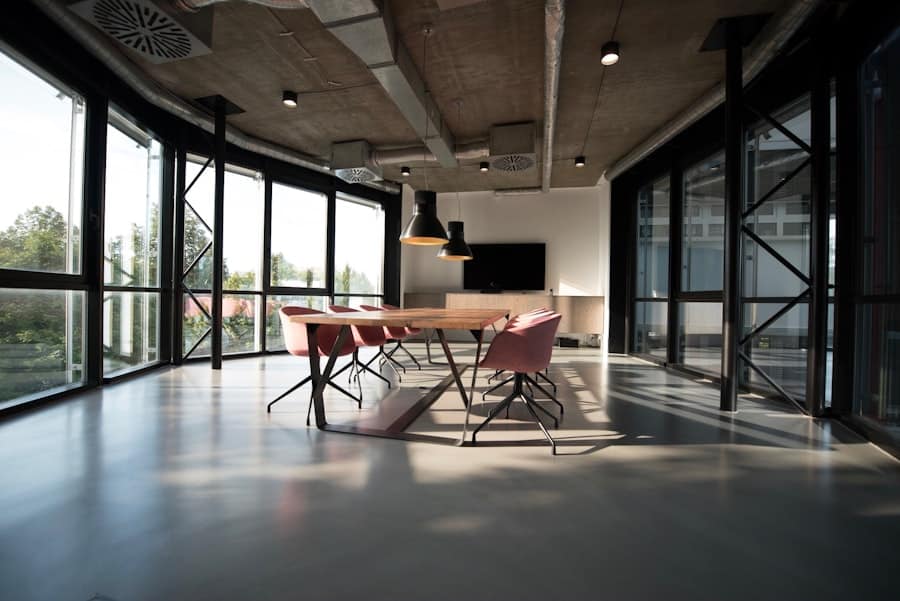Augmented Reality (AR) has emerged as a transformative technology that blends the physical and digital worlds, creating immersive experiences that enhance user interaction and engagement.
By overlaying digital information onto the real world, AR enables a more intuitive and interactive approach to workplace design, allowing organizations to create spaces that are not only functional but also conducive to collaboration and creativity.
The integration of AR into virtual workplace design is particularly relevant in an era where remote work has become increasingly prevalent. As organizations adapt to hybrid work models, the need for effective virtual environments that foster productivity and connection has never been more critical. AR provides a unique opportunity to bridge the gap between physical and virtual spaces, allowing employees to visualize and manipulate their work environments in real-time.
This capability not only enhances the design process but also empowers employees to engage with their workspaces in ways that were previously unimaginable.
Key Takeaways
- Augmented reality (AR) offers new possibilities for designing virtual workplaces, creating immersive and interactive environments for remote teams.
- Using AR in virtual workplace design can lead to benefits such as improved spatial awareness, enhanced visualization, and better decision-making processes.
- AR plays a crucial role in facilitating collaboration and communication in virtual workplaces by enabling real-time interaction and shared experiences among team members.
- Implementing AR in virtual workplaces can lead to improved productivity and efficiency through streamlined processes, reduced errors, and optimized workflows.
- AR has a significant impact on employee training and onboarding in virtual workplaces, providing realistic simulations and interactive learning experiences for new hires.
The Benefits of Using Augmented Reality in Virtual Workplace Design
One of the most significant benefits of employing AR in virtual workplace design is the ability to visualize complex spatial arrangements before implementation. Traditional design methods often rely on 2D blueprints or static models, which can limit understanding and hinder effective decision-making. In contrast, AR allows designers and stakeholders to interact with 3D models in real-time, providing a more comprehensive understanding of how different elements will coexist within a space.
For instance, an architect can use AR to project a virtual office layout onto a physical space, enabling clients to walk through and experience the design firsthand. This immersive experience can lead to more informed feedback and ultimately result in a workspace that better meets the needs of its users. Moreover, AR facilitates rapid prototyping and iteration in the design process.
Designers can quickly modify elements of a virtual workspace based on user feedback or changing requirements, significantly reducing the time and resources typically associated with traditional design methods. This agility is particularly beneficial in fast-paced industries where adaptability is crucial. By leveraging AR, organizations can create dynamic work environments that evolve alongside their business needs, ensuring that the virtual workplace remains relevant and effective.
The Role of Augmented Reality in Enhancing Collaboration and Communication in Virtual Workplaces
Collaboration is a cornerstone of any successful workplace, and AR plays a pivotal role in enhancing communication among team members, especially in virtual settings. With AR tools, employees can share their perspectives in real-time, overlaying digital content onto their physical surroundings during meetings or brainstorming sessions. This capability allows for a more interactive exchange of ideas, as participants can visualize concepts together rather than relying solely on verbal descriptions or static presentations.
For example, a team working on a product design can use AR to project 3D models of their prototypes during discussions, enabling all members to provide input based on a shared visual reference. Furthermore, AR can help bridge geographical barriers by creating a sense of presence among remote team members. Virtual meetings can be enhanced with AR features that allow participants to interact with shared digital objects as if they were physically present in the same room.
This immersive experience fosters a stronger sense of connection and collaboration, which is often lacking in traditional video conferencing tools. By utilizing AR for collaborative tasks, organizations can cultivate a more cohesive team dynamic, ultimately leading to improved outcomes and innovation.
How Augmented Reality Can Improve Productivity and Efficiency in Virtual Workplaces
The integration of AR into virtual workplaces has the potential to significantly boost productivity and efficiency among employees. One way this is achieved is through streamlined workflows that reduce the time spent on mundane tasks. For instance, AR applications can provide real-time guidance for complex procedures or tasks, allowing employees to access information hands-free while they work.
In manufacturing settings, workers can use AR glasses to receive step-by-step instructions overlaid on their field of vision, minimizing errors and enhancing speed. This hands-free approach not only accelerates task completion but also allows employees to focus on higher-value activities. Additionally, AR can facilitate better time management by providing employees with tools that help prioritize tasks and visualize their schedules.
For example, an employee could use an AR application to project their calendar onto their workspace, allowing them to see upcoming meetings and deadlines at a glance. This visual representation can help individuals allocate their time more effectively and reduce the likelihood of missed appointments or overlapping commitments. By enhancing time management capabilities through AR, organizations can create a more efficient work environment that maximizes employee output.
The Impact of Augmented Reality on Employee Training and Onboarding in Virtual Workplaces
Employee training and onboarding are critical components of organizational success, and AR has the potential to revolutionize these processes within virtual workplaces. Traditional training methods often involve lengthy manuals or passive video tutorials that may not engage learners effectively. In contrast, AR provides an interactive learning experience that immerses employees in realistic scenarios relevant to their roles.
For instance, new hires in technical fields can use AR simulations to practice troubleshooting equipment or navigating software systems in a risk-free environment. This hands-on approach not only enhances retention but also builds confidence as employees gain practical experience before facing real-world challenges. Moreover, AR can facilitate ongoing training by providing just-in-time resources that employees can access as needed.
For example, an employee encountering a new software tool can use an AR application to overlay instructional prompts directly onto their screen while they work. This immediate access to information reduces the need for extensive training sessions and allows employees to learn at their own pace. By integrating AR into training and onboarding processes, organizations can create a more adaptable workforce equipped with the skills necessary to thrive in an ever-evolving business landscape.
The Challenges and Limitations of Using Augmented Reality in Designing Virtual Workplaces
Despite its numerous advantages, the implementation of AR in designing virtual workplaces is not without challenges and limitations. One significant hurdle is the technological barrier associated with adopting AR solutions. Organizations may face difficulties in integrating AR tools into existing systems or may lack the necessary infrastructure to support such technologies.
Additionally, there may be resistance from employees who are unfamiliar with AR or hesitant to adopt new tools due to concerns about usability or effectiveness. Another challenge lies in ensuring that AR experiences are designed with user experience in mind. Poorly designed AR applications can lead to frustration or confusion among users, negating the potential benefits of the technology.
It is essential for organizations to invest time and resources into user-centered design processes that prioritize usability and accessibility. Furthermore, as with any technology, there are concerns regarding data privacy and security when using AR applications that collect user information or track interactions within virtual environments.
Case Studies of Successful Implementation of Augmented Reality in Virtual Workplace Design
Several organizations have successfully harnessed the power of AR to enhance their virtual workplace designs, demonstrating its potential across various industries. One notable example is Boeing, which has integrated AR into its assembly processes for aircraft manufacturing.
This innovative approach not only streamlines operations but also enhances employee training by providing real-time guidance during complex tasks. Another compelling case study comes from IKEA, which has utilized AR technology through its mobile application to enhance customer engagement and improve product visualization. Customers can use the app to place virtual furniture within their homes before making a purchase decision.
This application not only enhances the shopping experience but also serves as an example of how AR can be leveraged within virtual workplaces for design purposes. By allowing employees to visualize products in real-world settings, IKEA fosters collaboration between design teams and customers while ensuring that products meet user needs effectively.
The Future of Augmented Reality in Shaping the Virtual Workplace Environment
As technology continues to evolve, the future of augmented reality in shaping virtual workplace environments appears promising. Advancements in hardware capabilities, such as lighter and more comfortable AR headsets, will likely enhance user adoption and engagement with these tools. Additionally, improvements in software development will enable more sophisticated applications that cater specifically to the needs of diverse industries and work environments.
Furthermore, as organizations increasingly recognize the value of immersive experiences for employee engagement and productivity, we can expect a surge in investment toward developing tailored AR solutions for various workplace scenarios. The integration of artificial intelligence with AR could also lead to more personalized experiences for users, adapting content based on individual preferences or performance metrics. In conclusion, augmented reality stands poised to redefine how we design and interact within virtual workplaces.
Its ability to enhance collaboration, improve productivity, facilitate training, and create immersive experiences positions it as a vital tool for organizations navigating the complexities of modern work environments. As we look ahead, embracing this technology will be essential for organizations seeking to foster innovation and adaptability in an ever-changing landscape.
In a recent article on enicomp.com, the top trends on LinkedIn for 2023 were discussed, highlighting the growing importance of virtual workplaces and the role of augmented reality in designing them. This aligns with the concept explored in “The Role of Augmented Reality in Designing Virtual Workplaces,” as both articles emphasize the impact of technology on modern work environments. To stay ahead of the curve, professionals can also learn about how to choose the right laptop for video editing and explore software tools like the free Studio3 to SVG converter from Ideas R Us. These resources can help individuals enhance their skills and adapt to the evolving landscape of virtual workspaces. Read more
FAQs
What is augmented reality (AR) in the context of designing virtual workplaces?
Augmented reality (AR) is a technology that superimposes digital information such as images, videos, or 3D models onto the real world, typically viewed through a device such as a smartphone or AR glasses. In the context of designing virtual workplaces, AR can be used to overlay virtual elements onto physical spaces to create immersive and interactive environments.
How can augmented reality be used in designing virtual workplaces?
Augmented reality can be used in designing virtual workplaces by allowing designers to visualize and interact with virtual elements in a real-world context. This can include placing virtual furniture in a physical space to see how it fits and looks, or overlaying virtual screens and interfaces onto physical surfaces to simulate a digital workspace.
What are the benefits of using augmented reality in designing virtual workplaces?
Using augmented reality in designing virtual workplaces can provide several benefits, including the ability to visualize and test design concepts in real-world environments, improve collaboration and communication among design teams, and create more immersive and engaging virtual workplace experiences for end users.
What are some examples of augmented reality applications in designing virtual workplaces?
Examples of augmented reality applications in designing virtual workplaces include using AR to visualize and test office layouts, simulate virtual meetings and collaboration spaces, and create interactive training and onboarding experiences for remote employees.
What are the challenges of using augmented reality in designing virtual workplaces?
Challenges of using augmented reality in designing virtual workplaces may include technical limitations of AR hardware and software, the need for specialized skills and expertise in AR design and development, and potential privacy and security concerns related to using AR in workplace environments.



